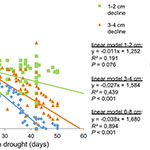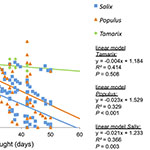Wetlands in general - case studies
About case studies
Wetlands such as riparian flood plains provide many important services to society including hydrological functions (groundwater recharge, floodwater detention), biogeochemical functions (nutrient or carbon retention) and ecological functions (maintenance of habitats). Wetlands have been generally declining – in both area and quality – in Europe for decades, a trend associated with negative effects for the water environment and associated riparian biota. Therefore, there is a strong need to collect experimental data and identify indicator species that are sensitive to climate change in order to predict future vegetation responses.
In REFRESH field experiments are conducted in five European countries: Sweden, Denmark, the Netherlands, Germany and Spain. Within a shared experimental set-up the partners involved in Work Package two and four of the REFRESH project work on several ecological, biogeochemical and hydrological aspects.
In the upcoming months the results of REFRESH work on riparian wetlands will be available here:
- European map of the spatial extent and environmental state of riparian wetlands.
- Review on processes and effects of temperature regimes on riparian wetland key functions and biodiversity: (1) Wetland biogeochemical functioning, (2) habitat provisioning, (3) connectivity and (4) biodiversity.
- Mechanistic-based predictions of the effects of temperature changes on the chemistry and ecological functioning of riparian wetlands.
- A practical report/document with the concept of approaching targets or reference conditions with a flexible, change based methodology for adaptive management and restoration efforts.
- Report providing tools for vulnerability assessment in natural, managed and restored riparian wetlands.
- Practical report/document on which HD Annex II, red-listed, and typical species are most vulnerable in a climate change context, and which Habitat Directive riparian habitat types are most vulnerable to climate change
- Guidelines on climate change proof innovative adaptive and cost-effective riparian wetland management (mitigation, adaptation, and restoration) strategies to counteract negative effects of climate-driven changes on riparian wetlands ecosystems, with special focus on effects of temperature changes, changes in water level fluctuations, changes in nutrient loading and their interactions
For further reading
- Burgmer, T., Hillebrand, H., & Pfenninger, M. (2007). Effects of climate-driven temperature changes on the diversity of freshwater macroinvertebrates. Oecologia, 151(1), 93–103. doi:10.1007/s00442-006-0542-9
link to article - Logez, M., Bady, P., & Pont, D. (2012). Modelling the habitat requirement of riverine fish species at the European scale: sensitivity to temperature and precipitation and associated uncertainty. Ecology of Freshwater Fish, 21(2), 266–282. doi:10.1111/j.1600-0633.2011.00545.x
link to article
Selected case studies
Effects of climate-induced increases in summer drought on riparian plant species: a meta-analysis. (REFRESH outcome)

Cited work:
Garssen, A.G., Verhoeven, J.T.A., Soons, M.B. (2013). Submitted scientific article (31 May 2013).
Ecosystem type:
Riparian wetlands (along streams)
Variable being affected:
Biological (vegetation)
Key message:
The projected increase in the frequency and duration of drought periods are expected to accelerate riparian wetland species losses in the near future and may lead to an increased presence of species adjusted to drier conditions. An increase in duration and intensity of drought negatively affects riparian plant biomass and seedling survival.
Background:
Climate-induced increases in summer drought are predicted to have considerable effects on riparian plant community composition and species richness. At times of water stress, plant biomass decreases, thereby reducing water loss. The seedling stage is especially sensitive as seedlings are known to respond rapidly to changing abiotic conditions. Eventually, species are expected to be replaced by other, more drought-tolerant species. The authors reviewed published articles on species richness and conducted a meta-analysis of data to quantify the effects of increases in duration and intensity of drought on riparian plant biomass and seedling survival. Articles were selected that focused on riparian wetlands along streams or rivers, or relevant mesocosm / greenhouse experiments, carried out with typical riparian wetland plants.
 Click to enlarge
Click to enlarge
Main results:
An increase in the duration and intensity of drought in general results in an eventual decline in riparian plant species richness, with a shift in species composition from hydric species to mesic and/or xeric species in drought-affected sites. According to this shift, the riparian zone with hydric species is reduced or narrowed, and part of it is replaced by a zone with mesic or even xeric terrestrial species. Herbaceous species are expected to be more sensitive to the direct effects of rainfall declines, while tree species are more sensitive to prolonged, more severe stream discharge declines which also affect groundwater tables. This may lead to a decline in herbaceous species in the short term, and a decrease in tree species on the long run due to an expected increase in the frequency and duration of droughts.
 Click to enlarge
Click to enlarge
Groundwater level, surface flow permanence and the presence of plant traits conducive to drought tolerance, most notably plasticity in root elongation, were mentioned as the most important factors determining the changes in species richness and composition. These results were found across (semi-)arid, Atlantic and Mediterranean systems. Our meta-analysis confirms that a longer duration and greater intensity of drought negatively affect riparian plant total biomass (dry weight), starting from a drought duration of approximately > 30 days. An increase in the duration and intensity of drought has a pronounced negative linear effect on seedling survival.
 Click to enlarge
Click to enlarge
The differences found between seedlings of the three common riparian tree genera Populus, Salix and Tamarix are consistent with their general habitat preferences, with both Populus and Salix showing a negative relationship of survival in response to increasing duration of drought, while Tamarix is not affected. Tamarix seedlings can cope relatively well with drought conditions, due to their ability to rapidly and expansively elongate their roots. Changes in species composition are expected towards plant communities with more drought-tolerant species.
Climate change and the future distributions of aquatic macrophytes across boreal catchments
Cited work:
Alahuhta, J., Heino, J., & Luoto, M. (2011). Climate change and the future distributions of aquatic macrophytes across boreal catchments. Journal of Biogeography, 38(2), 383–393. doi:10.1111/j.1365-2699.2010.02412.x
Ecosystem type:
General
Variable being affected:
Biological (primary producers)
Background:
Aquatic–terrestrial ecotones are vulnerable to climate change, and degradation of the emergent aquatic macrophyte zone would have severe ecological consequences for freshwater, wetland and terrestrial ecosystems. The aim of this study was to uncover future changes in boreal emergent aquatic macrophyte zones by modelling the occurrence and percentage cover of emergent aquatic vegetation under different climate scenarios in Finland by the 2050s. Data derived from different GIS sources were used to estimate future emergent aquatic macrophyte distributions in all catchments in Finland (848 in total). Generalized additive models (GAM) were used to explore the main environmental determinates (climate and geomorphology) of emergent aquatic macrophyte distributions, which were derived from the national subclass of CORINE land- cover classification. The accuracy of the distribution models (GAMs) was cross- validated, using percentage of explained deviance and the area under the curve derived from the receiver-operating characteristic plots.
Main results:
The results indicated that emergent aquatic macrophytes will expand their distributions northwards from the current catchments and percentage cover will increase in all of the catchments in all climate scenarios. Growing degree-days was the primary determinant affecting distributions of emergent aquatic macrophytes. Inclusion of geomorphological variables clearly improved model performance in both model exercises compared with pure climate variables.
Conclusions:
Emergent aquatic macrophyte distributions will expand due to climate change. Many emergent aquatic plant species have already expanded their distributions during the past decades, and this process will continue in the years 2051–80. Emergent aquatic macrophytes pose an increasing overgrowth risk for sensitive macrophyte species in boreal freshwater ecosystems, which should be acknowledged in management and conservation actions. We conclude that predictions based on GIS data can provide useful ‘first-filter’ estimates of changes in aquatic–terrestrial ecotones.









